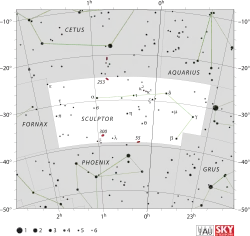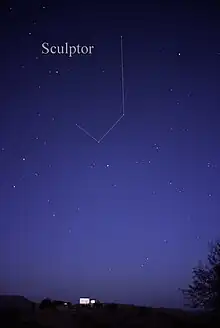| Constellation | |
 | |
| Abbreviation | Scl |
|---|---|
| Genitive | Sculptoris |
| Pronunciation | /ˈskʌlptər/, genitive /skəlpˈtɒrɪs/ |
| Symbolism | the Sculptor |
| Right ascension | 0h |
| Declination | −30° |
| Quadrant | SQ1 |
| Area | 475 sq. deg. (36th) |
| Main stars | 4 |
| Bayer/Flamsteed stars | 18 |
| Stars with planets | 6 |
| Stars brighter than 3.00m | 0 |
| Stars within 10.00 pc (32.62 ly) | 2 |
| Brightest star | α Scl (4.30m) |
| Messier objects | 0 |
| Bordering constellations | Cetus Aquarius Piscis Austrinus Grus Phoenix Fornax |
| Visible at latitudes between +50° and −90°. Best visible at 21:00 (9 p.m.) during the month of November. | |
Sculptor is a faint constellation in the southern sky. It represents a sculptor. It was introduced by Nicolas Louis de Lacaille in the 18th century. He originally named it Apparatus Sculptoris (the sculptor's studio), but the name was later shortened.
History

The region to the south of Cetus and Aquarius had been named by Aratus in 270 BC as The Waters – an area of scattered faint stars with two brighter stars standing out. Professor of astronomy Bradley Schaefer has proposed that these stars were most likely Alpha and Delta Sculptoris.[1]
The French astronomer Nicolas-Louis de Lacaille first described the constellation in French as l'Atelier du Sculpteur (the sculptor's studio) in 1751–52,[2][3] depicting a three-legged table with a carved head on it, and an artist's mallet and two chisels on a block of marble alongside it.[4] Lacaille had observed and catalogued almost 10,000 southern stars during a two-year stay at the Cape of Good Hope, devising fourteen new constellations in uncharted regions of the Southern Celestial Hemisphere not visible from Europe. He named all but one in honour of instruments that symbolised the Age of Enlightenment.[lower-alpha 1][5]
Characteristics

Sculptor is a small constellation bordered by Aquarius and Cetus to the north, Fornax to the east, Phoenix to the south, Grus to the southwest, and Piscis Austrinus to the west. The bright star Fomalhaut is nearby.[6] The three-letter abbreviation for the constellation, as adopted by the International Astronomical Union in 1922, is "Scl".[7] The official constellation boundaries, as set by Belgian astronomer Eugène Delporte in 1930,[lower-alpha 2] are defined by a polygon of 6 segments. In the equatorial coordinate system, the right ascension coordinates of these borders lie between 23h 06.4m and 01h 45.5m , while the declination coordinates are between −24.80° and −39.37°.[9] The whole constellation is visible to observers south of latitude 50°N.[lower-alpha 3]
.jpg.webp)
Notable features
Stars
.jpg.webp)
No stars brighter than 3rd magnitude are located in Sculptor. This is explained by the fact that Sculptor contains the south galactic pole[12] where stellar density is very low. Overall, there are 56 stars within the constellation's borders brighter than or equal to apparent magnitude 6.5.[lower-alpha 4][10]
The brightest star is Alpha Sculptoris, an SX Arietis-type variable star with a spectral type B7IIIp and an apparent magnitude of 4.3.[14] It is 780 ± 30 light-years distant from Earth.[15]
Eta Sculptoris is a red giant of spectral type M4III that varies between magnitudes 4.8 and 4.9, pulsating with multiple periods of 22.7, 23.5, 24.6, 47.3, 128.7 and 158.7 days.[16] Estimated to be around 1,082 times as luminous as the Sun,[17] it is 460 ± 20 light-years distant from Earth.[18]
R Sculptoris is a red giant that has been found to be surrounded by spirals of matter likely ejected around 1800 years ago. It is 1,440 ± 90 light-years distant from Earth.[19]
The Astronomical Society of Southern Africa in 2003 reported that observations of the Mira variable stars T, U, V and X Sculptoris were very urgently needed as data on their light curves was incomplete.[20]
Deep sky objects
The constellation also contains the Sculptor Dwarf, a dwarf galaxy which is a member of the Local Group, as well as the Sculptor Group, the group of galaxies closest to the Local Group. The Sculptor Galaxy (NGC 253), a barred spiral galaxy and the largest member of the group, lies near the border between Sculptor and Cetus. Another prominent member of the group is the irregular galaxy NGC 55.
One unique galaxy in Sculptor is the Cartwheel Galaxy, at a distance of 500 million light-years. The result of a merger around 300 million years ago, the Cartwheel Galaxy has a core of older, yellow stars, and an outer ring of younger, blue stars, which has a diameter of 100,000 light-years. The smaller galaxy in the collision is now incorporated into the core, after moving from a distance of 250,000 light-years. The shock waves from the collision sparked extensive star formation in the outer ring.[21]
Namesakes
Sculptor (AK-103) was a United States Navy Crater class cargo ship named after the constellation.
See also
References
Notes
- ↑ The exception is Mensa, named for the Table Mountain. The other thirteen (alongside Sculptor) are Antlia, Caelum, Circinus, Fornax, Horologium, Microscopium, Norma, Octans, Pictor, Pyxis, Reticulum and Telescopium.[5]
- ↑ Delporte had proposed standardising the constellation boundaries to the International Astronomical Union, who had agreed and gave him the lead role[8]
- ↑ While parts of the constellation technically rise above the horizon to observers between 50°N and 65°N, stars within a few degrees of the horizon are to all intents and purposes unobservable.[10]
- ↑ Objects of magnitude 6.5 are among the faintest visible to the unaided eye in suburban-rural transition night skies.[13]
Citations
- ↑ Schaefer, Bradley E. (2002). "The latitude and epoch for the formation of the southern Greek constellations". Journal for the History of Astronomy. 33, part 4 (113): 313–50. Bibcode:2002JHA....33..313S. doi:10.1177/002182860203300401. ISSN 0021-8286. S2CID 122459258.
- ↑ Ridpath, Ian. "Lacaille's Southern Planisphere of 1756". Star Tales. Self-published. Retrieved 25 August 2015.
- ↑ Lacaille, Nicolas Louis (1756). "Relation abrégée du Voyage fait par ordre du Roi au cap de Bonne-espérance". Mémoires de l'Académie Royale des Sciences (in French): 519–592 [589].
- ↑ Ridpath, Ian. "Sculptor". Star Tales. Retrieved 3 December 2016.
- 1 2 Wagman 2003, pp. 5–6.
- ↑ Klepešta, Josef; Rükl, Antonín (1974) [1969]. Constellations. Hamlyn. pp. 234–35. ISBN 0-600-00893-2.
- ↑ Russell, Henry Norris (1922). "The new international symbols for the constellations". Popular Astronomy. 30: 469. Bibcode:1922PA.....30..469R.
- ↑ Ridpath, Ian. "Constellation boundaries: How the modern constellation outlines came to be". Star Tales. self-published. Retrieved 1 June 2016.
- ↑ "The Constellations: Sculptor, constellation boundary". International Astronomical Union. Retrieved 4 December 2016.
- 1 2 Ridpath, Ian. "Constellations". Star Tales. self-published. Retrieved 1 June 2016.
- ↑ "Surprising Spiral Structure Spotted by ALMA". ESO Press Release. Retrieved 11 October 2012.
- ↑ Blaauw, A.; Gum, C.S.; Pawsey, J.L.; Westerhout, G. (1960). "The new IAU system of galactic coordinates (1958 revision)". Monthly Notices of the Royal Astronomical Society. 121 (2): 123. Bibcode:1960MNRAS.121..123B. doi:10.1093/mnras/121.2.123.
- ↑ Bortle, John E. (February 2001). "The Bortle Dark-Sky Scale". Sky & Telescope. Sky Publishing Corporation. Retrieved 4 March 2016.
- ↑ "Alpha Sculptoris– Rotationally Variable Star". SIMBAD Astronomical Database. Centre de Données astronomiques de Strasbourg. Retrieved 5 December 2013.
- ↑ van Leeuwen, F. (2007). "Validation of the New Hipparcos Reduction". Astronomy and Astrophysics. 474 (2): 653–64. arXiv:0708.1752. Bibcode:2007A&A...474..653V. doi:10.1051/0004-6361:20078357. S2CID 18759600.
- ↑ Tabur, V.; Bedding, T. R. (2009). "Long-term photometry and periods for 261 nearby pulsating M giants". Monthly Notices of the Royal Astronomical Society. 400 (4): 1945–61. arXiv:0908.3228. Bibcode:2009MNRAS.400.1945T. doi:10.1111/j.1365-2966.2009.15588.x. S2CID 15358380.
- ↑ McDonald, I.; Zijlstra, A. A.; Boyer, M. L. (2012). "Fundamental parameters and infrared excesses of Hipparcos stars". Monthly Notices of the Royal Astronomical Society. 427 (1): 343–357. arXiv:1208.2037. Bibcode:2012MNRAS.427..343M. doi:10.1111/j.1365-2966.2012.21873.x. S2CID 118665352. Vizier catalog entry
- ↑ Brown, A. G. A.; et al. (Gaia collaboration) (August 2018). "Gaia Data Release 2: Summary of the contents and survey properties". Astronomy & Astrophysics. 616. A1. arXiv:1804.09365. Bibcode:2018A&A...616A...1G. doi:10.1051/0004-6361/201833051. Gaia DR2 record for this source at VizieR.
- ↑ Brown, A. G. A.; et al. (Gaia collaboration) (August 2018). "Gaia Data Release 2: Summary of the contents and survey properties". Astronomy & Astrophysics. 616. A1. arXiv:1804.09365. Bibcode:2018A&A...616A...1G. doi:10.1051/0004-6361/201833051. Gaia DR2 record for this source at VizieR.
- ↑ Cooper, Tim (2003). "Presidential address: Amateur Observations – Successes and Opportunities". Monthly Notes of the Astronomical Society of Southern Africa. 62: 234–240. Bibcode:2003MNSSA..62..234C.
- ↑ Wilkins, Jamie; Dunn, Robert (2006). 300 Astronomical Objects: A Visual Reference to the Universe. Buffalo, New York: Firefly Books. ISBN 978-1-55407-175-3.
Sources
- Ridpath, Ian (2001), Stars and Planets Guide, Princeton University Press, ISBN 0-691-08913-2
- Wagman, Morton (2003). Lost Stars: Lost, Missing and Troublesome Stars from the Catalogues of Johannes Bayer, Nicholas Louis de Lacaille, John Flamsteed, and Sundry Others. Blacksburg, VA: The McDonald & Woodward Publishing Company. ISBN 978-0-939923-78-6.